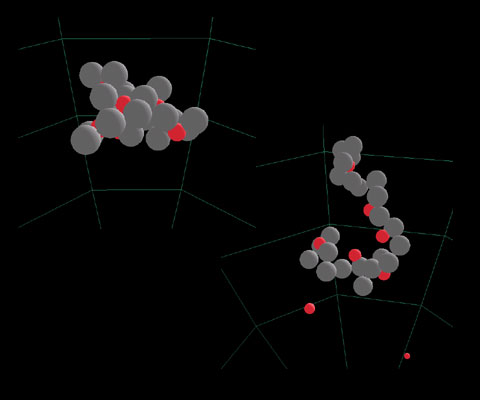Previous Research Page
Contents
Overview
Computational chemistry
Molecular dynamics
Overview
My undergraduate degree was in astrophysics and applied mathematics, particularly computational mathematics. As such I have applied computational modelling techniques to a wide variety of projects in various disciplines, an example of some of these are below.
Computational chemistry
 |
This research project involved investigating computational methods to mathematically model Polyelectrolytes (e.g. DNA) under different environments (see publications). We were particularly interested in how the shape of these long chain-like molecules is affected by the surrounding liquid medium. Our model consisted of a Metropolis Monte Carlo Method, modified to work across multiple processors. The modifications made resulted in being able to get super-linear speed-up when each processor was investigating slightly different physical parameters (such as temperature and the dialectic constant of the surrounding liquid), and all of these ensembles were of interest. For additional details see my final (overheads) presentation in PDF form. |
This work was carried out at the University of Melbourne and was an extension of work begun as an intern for summer 2001/2002 while at the Victorian Partnership for Advanced Computing (VPAC). After the summer internship I was employed as a Research Assistant by (Prof. Derek Chan) throughout 2002 and early 2003. During this time I was working with Malek Khan at the Department of Mathematics and Statistics, as part of the Continuum Modelling Group.
Molecular dynamics
|
The picture shown here is a snapshot of an animation produced at the Victorian College of Pharmacy (now the Monash Institute of Pharmaceutical Sciences) during my time as a summer intern at the Victorian Partnership for Advanced Computing (VPAC) in 2001/2. The snapshot shows a "stick and ball" representation of an Outer Membrane Protein (OmpA). The thick red lines show the backbone of the barrel protein, which has the function of allowing the transport of specific sized material through the membrane wall. This is used in many ways, one of these is to filter material coming into a cell (for example small ions - as is the case here), others include dynamically threading bacterial proteins into the external environment. Here hydrogen (H) is not displayed (as it clogs the image), carbon (C) is shown in green, nitrogen (N) in blue, oxygen (O) in red, and sulphur (S) in yellow. This image was produced using NAMD in conjunction with David Chalmers, Monash. |
 |